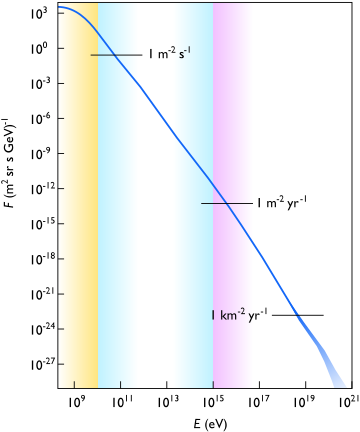Cosmic ray facts for kids

Cosmic rays are very high-energy radiation, mostly from outside the Solar System.
The term ray is a historical accident, as cosmic rays were at first, and wrongly, thought to be mostly electromagnetic radiation.
They are particles. Most are protons and alpha particles, which are the nuclei of helium atoms. Some are electrons (beta particles), gamma rays or photons and a tiny fraction are even heavier particles.
Contents
Origin
Their origin is not exactly known. There is evidence that many primary cosmic rays come from the supernovae of massive stars. However, this is not thought to be their only source.
Discovery
In 1909, Theodor Wulf developed an electrometer, a device to measure the rate of ion production inside a hermetically sealed container, and used it to show higher levels of radiation at the top of the Eiffel Tower than at its base. However, his paper published in Physikalische Zeitschrift was not widely accepted. In 1911, Domenico Pacini observed simultaneous variations of the rate of ionization over a lake, over the sea, and at a depth of 3 metres from the surface. Pacini concluded from the decrease of radioactivity underwater that a certain part of the ionization must be due to sources other than the radioactivity of the Earth.
Hess received the Nobel Prize in Physics in 1936 for his discovery.
In 1912, Victor Hess carried three enhanced-accuracy Wulf electrometers to an altitude of 5,300 metres in a free balloon flight. He found the ionization rate increased approximately fourfold over the rate at ground level. Hess ruled out the Sun as the radiation's source by making a balloon ascent during a near-total eclipse. With the moon blocking much of the Sun's visible radiation, Hess still measured rising radiation at rising altitudes. He concluded that "The results of the observations seem most likely to be explained by the assumption that radiation of very high penetrating power enters from above into our atmosphere." In 1913–1914, Werner Kolhörster confirmed Victor Hess's earlier results by measuring the increased ionization enthalpy rate at an altitude of 9 km.
Secondary cosmic rays
Cosmic rays can have as much energy as 1020 eV, far higher than the 1012 to 1013 eV that man-made particle accelerators can produce. When cosmic ray particles enter the Earth's atmosphere they hit other particles, like molecules of oxygen and nitrogen. This causes a shower of lighter particles, a so-called 'air shower'.
The number of particles made in an air shower event can reach billions. All of the particles in the shower stay within about one degree of the first particle's path. In a shower are x-rays, muons, protons, alpha particles, pions, electrons, and neutrons.
Typical particles produced in such collisions are neutrons and charged mesons such as positive or negative pions and kaons. Some of these decay into muons. These are able to reach the surface of the Earth, and even penetrate for some distance into shallow mines. The muons can be easily detected by many types of particle detectors. The observation of a secondary shower of particles in different detectors at the same time shows that all of the particles came from that event.
Practical importance
Effects on Earth chemistry
Cosmic rays are responsible for the continuous production of certain unstable isotopes in the Earth's atmosphere, such as carbon-14, by the reaction:
- n + 14N → p + 14C
Cosmic rays kept the level of carbon-14 in the atmosphere roughly constant (70 tons) for at least the past 100,000 years, until the beginning of above-ground nuclear weapons testing in the early 1950s. This is an important fact used in radiocarbon dating used in archaeology.
Effect on space vehicles
Cosmic rays are of great practical interest, because they can damage microelectronics and life outside the protection of the Earth's atmosphere and magnetic field.
Images for kids
-
The VERITAS array of air Cherenkov telescopes.
-
Comparison of radiation doses, including the amount detected on the trip from Earth to Mars by the RAD on the MSL (2011–2013).
See also
 In Spanish: Radiación cósmica para niños
In Spanish: Radiación cósmica para niños






